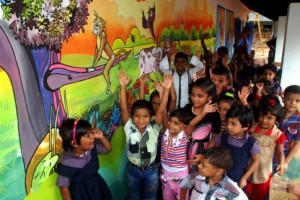Students at Government Upper Primary School Vellayil West in Kozhikode. Photo: S. Ramesh
Kerala on the South West Malabar Coast 15000 Square miles, has the highest literacy rate among the states of India and topped the Education Development Index (EDI) among 21 major states in India. More than 94% of the rural population has access to primary school within 1 km, while 98% of population benefits one school within a distance of 2 km.
The local government from June 2015, is to introduce multi-media “Digital Collaborative Textbooks” (DCT) and revolutionise the education sector. This DCM will include worldwide audio and video files and copy of textbook, including “ Hard Spots” with over 3000 contents covering wide range of topics.
The state government has also set up e-learning centres at school and support of tablets and laptops which can be accessed by students and teachers. Over 3.7m students and about more than 20, 000 teachers in the state-run schools are expected to benefit e-textbooks.
The department was also ready to share digital textbook model with private schools also which follow state syllabus. But, they should provide hardware and other supporting facilities to get the access, he said. Irrespective of their parents background be it be a farmer or heart surgeon, they can help their children to understand and read complex topics. Nearly £ 5m is allocated for the project, planned to be implemented with the technical support of the state-run Centre for Development of Imaging Technology (C-DIT).
In anticipation of e-learning centres over 5000 tablets have been bought costing £20 each.
This is just the beginning as the innovative digital text models could be accessed from anywhere in the world and enhance digitisation of India’s education sector.
Revised textbooks of class 1 to 12 in schools will have lessons about the evils of tobacco to create awareness among children and the need for smoke free schools according to Kerala education department. Most often children are attracted to smoking as they think it is a sign of smartness, by giving in to temptations and acquiring unhealthy habits, but rather acquiring the ability to say No.
